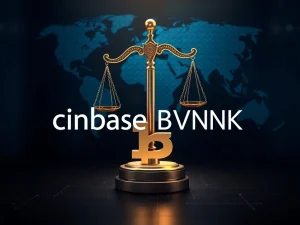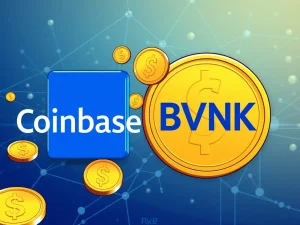Unlock Institutional Success: Why Blockchain Interoperability is Vital Now

In the rapidly evolving world of cryptocurrency and blockchain, one term is increasingly echoing through institutional corridors: blockchain interoperability. It’s no longer just a buzzword; it’s the linchpin for widespread institutional adoption and the key to unlocking the true potential of blockchain technology. But what exactly is it, and why is it so crucial for big players entering the crypto space? Let’s dive into the world of interconnected blockchains and explore how they are poised to revolutionize institutional finance.
The Imperative of Blockchain Interoperability for Institutional Growth
Imagine the internet without the ability to seamlessly connect different networks. Emails wouldn’t travel between providers, websites wouldn’t load across browsers, and the digital revolution as we know it would be nonexistent. This fragmented scenario mirrors the early stages of blockchain technology. Initially, blockchains operated in silos, isolated ecosystems with limited communication. Blockchain interoperability is the solution to this isolation, creating bridges that allow different blockchains to communicate, share data, and transact with each other. This connectivity is not just a technical nicety; it’s a fundamental requirement for institutions aiming to leverage blockchain’s transformative power.
Why is Interoperability a Game Changer for Institutions?
For institutions considering or already venturing into the digital asset realm, blockchain interoperability offers a plethora of compelling advantages:
- Enhanced Efficiency and Reduced Silos: Large institutions often operate across various departments and systems. Interoperability breaks down data silos, allowing for seamless information flow and streamlined operations across different blockchain platforms.
- Greater Flexibility and Choice: Institutions are not locked into a single blockchain ecosystem. They can choose the best blockchain for specific applications (e.g., supply chain, payments, identity management) and ensure they work together harmoniously.
- Expanded Market Reach: Interoperability facilitates cross-chain transactions, opening up access to a wider range of digital assets and markets. Institutions can tap into liquidity and opportunities across diverse blockchain networks.
- Innovation and New Use Cases: The ability for blockchains to interact fosters innovation. It enables the development of complex, cross-chain applications and services that were previously impossible, unlocking new use cases for institutions.
- Risk Diversification: By not being reliant on a single blockchain, institutions can diversify their risk and reduce vulnerability to the potential failures or limitations of any single network.
Unpacking the Benefits of Blockchain Interoperability
Let’s delve deeper into the tangible benefits that blockchain interoperability brings to the table for institutions:
| Benefit | Description | Institutional Impact |
|---|---|---|
| Asset Portability | Seamless movement of digital assets across different blockchains. | Enables institutions to manage and utilize assets more efficiently, regardless of the originating blockchain. |
| Data Sharing | Secure and controlled sharing of data between blockchains. | Facilitates better decision-making, improved compliance, and enhanced transparency across institutional operations. |
| Smart Contract Composability | Smart contracts on different blockchains can interact and trigger actions on other chains. | Opens doors for complex financial instruments and automated workflows spanning multiple blockchain ecosystems. |
| Scalability Solutions | Interoperability can help distribute transaction load across multiple blockchains. | Addresses scalability concerns, enabling institutions to handle high volumes of transactions efficiently. |
Navigating the Challenges of Cross-Chain Solutions
While the promise of blockchain interoperability is immense, it’s important to acknowledge the challenges that need to be addressed for its widespread institutional adoption:
- Security Concerns: Cross-chain bridges can introduce new security vulnerabilities. Ensuring the security of these bridges is paramount to prevent exploits and protect institutional assets.
- Complexity of Implementation: Developing and implementing interoperable solutions can be technically complex, requiring specialized expertise and careful planning.
- Standardization and Regulation: The lack of universal standards and clear regulatory frameworks for interoperability can create uncertainty and hinder adoption.
- Scalability of Interoperability Solutions: As the number of interconnected blockchains grows, ensuring the scalability of interoperability solutions themselves becomes crucial.
- Maintaining Decentralization: Some interoperability solutions may introduce centralization points, potentially compromising the decentralized nature of blockchain technology.
Examples of Blockchain Interoperability in Action
Despite the challenges, the progress in blockchain interoperability is undeniable. Several projects are actively working on creating cross-chain solutions, showcasing the practical applications of this technology:
- Polkadot: A platform designed to enable different blockchains (parachains) to connect and communicate, facilitating data and asset transfer.
- Cosmos: A network of independent blockchains (zones) that can interoperate through the Inter-Blockchain Communication (IBC) protocol.
- Chainlink: A decentralized oracle network that enables smart contracts on one blockchain to securely access data and services from other blockchains and external sources.
- LayerZero: An omnichain interoperability protocol designed for lightweight message passing across chains.
Actionable Insights for Institutions Embracing Interoperability
For institutions ready to embrace the power of blockchain interoperability, here are some actionable insights:
- Educate and Explore: Invest in understanding the different types of interoperability solutions and their potential applications within your institution.
- Strategic Partnerships: Collaborate with blockchain technology providers and interoperability specialists to develop and implement tailored solutions.
- Prioritize Security: Thoroughly vet interoperability solutions for security vulnerabilities and implement robust security measures.
- Start with Pilot Projects: Begin with small-scale pilot projects to test and validate the benefits of interoperability before large-scale deployment.
- Engage in Industry Collaboration: Participate in industry initiatives and working groups focused on standardization and best practices for blockchain interoperability.
The Future is Interconnected: Embracing Blockchain Technology
Blockchain interoperability is not just a technical advancement; it’s a paradigm shift. It’s the bridge that connects disparate blockchain islands into a cohesive and powerful continent of decentralized innovation. For institutions seeking to thrive in the digital age, understanding and embracing interoperability is no longer optional – it’s essential. As the technology matures and adoption accelerates, the institutions that prioritize interoperability will be best positioned to capitalize on the vast potential of blockchain and lead the charge into a more connected and efficient future of finance.







